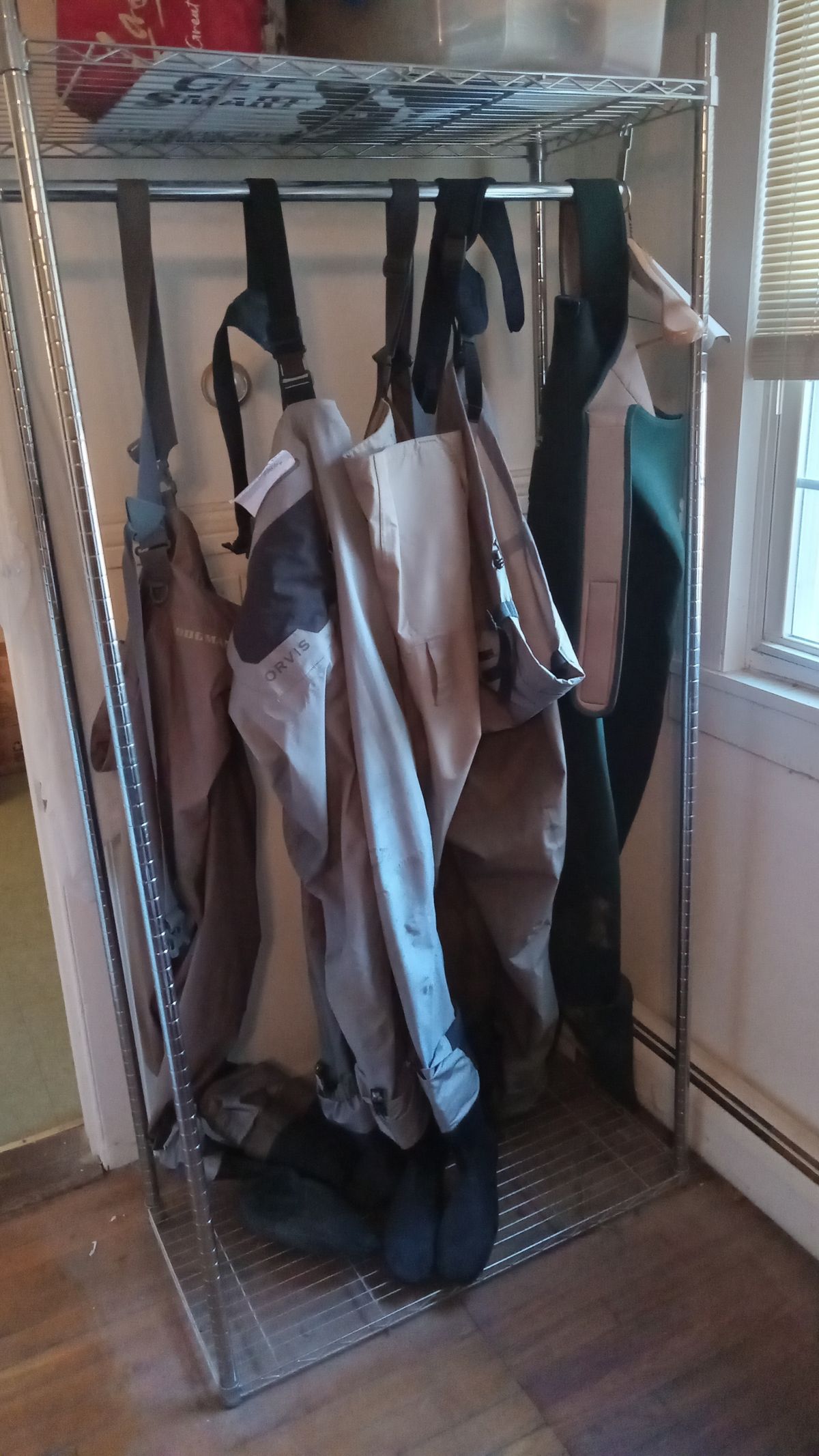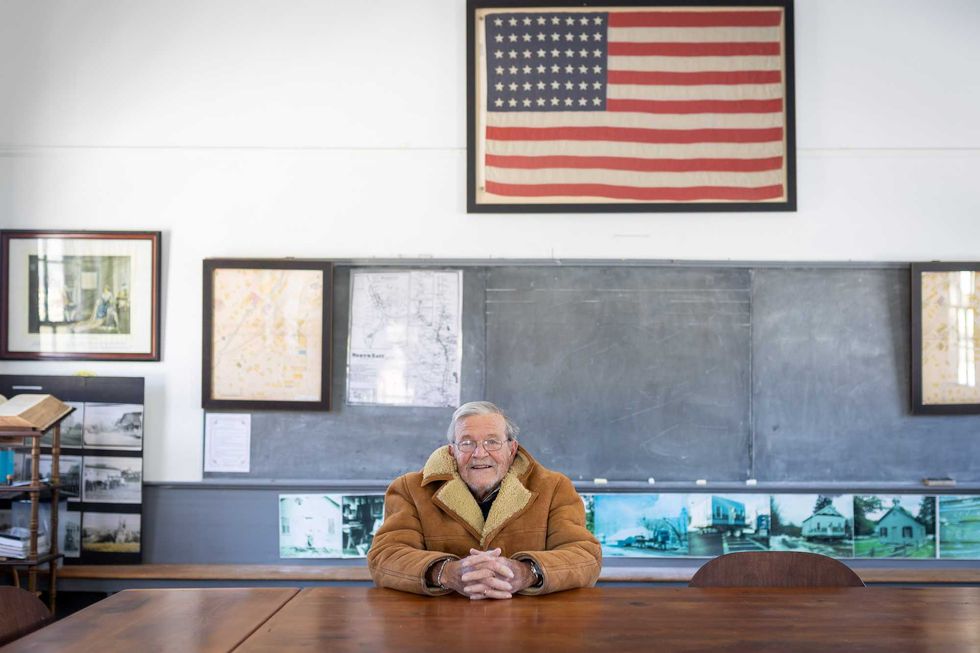Tangled Lines gift guide

The official Tangled Lines wader lineup. One set needs patching. One was purchased when the author was much larger. One never fit quite right but you never know. There’s another set in the car.
Patrick L. Sullivan

The official Tangled Lines wader lineup. One set needs patching. One was purchased when the author was much larger. One never fit quite right but you never know. There’s another set in the car.
Here is the annual gift guide for those of you with fly-fishers on the list. I have attempted to keep this simple and intelligible to the unafflicted.
The easy way out is the gift certificate. Most retailers offer them. I have been on the receiving end of an Orvis gift card many times.
So how much do you make it for? Hard to say, but know this: $100 just gets things started. If the goal is to get Fred a new set of waders so he stops complaining about the old leaky ones, better start at $300. Note also that they will still leak, eventually, but this is not your fault.
The old waders can probably be salvaged, too. Look for a wader repair kit with a small tube of stuff called Aquaseal and some patches that can be cut to size. Fred should have one of these kits anyway. Sometimes they come with the new waders.
Then you can get Fred a freestanding rack to hold all the spare waders that might or might not leak. (See photo.)
Rods: I am a big fan of Echo rods, especially the entry-level models. You can do a lot worse than getting a budding angler an Echo Lift kit, which is a rod, reel with pre-spooled line, and case for just under $200.
Anything else is going to require some subtlety on your part. Example: “Hi Fred. What sort of fly rod do you really want? And how’s Mom?”
Fred replies: “I have been eyeing the Spatzenjammer GBH 12-foot trout mini-spey for 250 grain Skagit heads.”
“I’m sorry to hear that,” you say, keeping it subtle. “Have you seen a specialist?”
For extra subtlety, try asking Fred’s main fishing buddy what a good rod would be. This could be difficult, because Fred probably doesn’t know his buddy’s last name, home town, or anything that might identify him except a phone number. And even that will be in some kind of code. I have a contact in my phone that says “K fishing.” That’s it. I have no idea who or what this is, and when I tried calling I got a no longer in service message. Didn’t delete it from the phone, though. That would make too much sense.
You could throw yourself on the mercy of the fly shop. We have two actual fly shops in driving distance -- the Orvis store in Avon, and UpCountry in the Pleasant Valley section of Barkhamsted, with the West Branch of the Farmington River out back.
You’ll need to know some basic stuff. Where does Fred fish? What does he fish for? And Fred’s dimensions, plus a quick sketch of his condition, habits and general disposition.
Here’s an idea that could work: A bunch of flies and a nifty new box from a big online fly retailer such as Big Y Fly Company in Oregon or Fly Shack in New York.
I’ll save you the guesswork. If your intended recipient is a trout person, get a Fishpond/Tacky Double Haul fly box (about $35) and the following flies, six of each: Chubby Chernobyl size 12, Parachute Adams size 12, Light Cahill dun size 14, Elk Hair caddis size 14, Stimulator size 6, Pheasant Tail beadhead size 16, Hare’s Ear beadhead size 16, and Leadwing Coachman size 10.
The total for this should be about $100.
Don’t put the flies in the box because you’ll do it wrong. Let Fred do it. It will take forever and the family, busy with festive holiday activities, will be grateful not to have the glum snowbound angler getting in the way.
Ralph Fedele sits at a desk in the historic Irondale Schoolhouse, which he led the effort to relocate to downtown Millerton.
MILLERTON — After serving for 12 years on the North East Town Board, Ralph Fedele says he has only one regret.
“I wish I could be called a ‘local,’” he joked with a warm, booming laugh.
Fedele moved to Millerton from New York City 37 years ago, in 1988, and has since worn many hats — volunteer, historian, advocate, elected official — yet he still doesn’t believe he’s earned that title.
“I’m a transplant,” he said matter of factly. “I’m from the city.”
Before settling in Millerton, Fedele spent 25 years working in merchandising at JCPenney.
His roots, however, trace back to Rhinebeck, where he grew up on a 97-acre farm and enjoyed what he describes as an idyllic childhood.
“It was marvelous,” he said, with a twinkle of nostalgia in his eyes. As a boy, he climbed apple trees, spent hours in the family barn’s hayloft, played with neighbors until sunset, and helped his Sicilian grandmother — his nonna — in the garden. Today, Fedele wears her ring. “Any time I’m a little depressed or I want to remember,” he said, “I can talk to her.”
Growing up with an Italian grandmother sparked a lifelong love of history and culture. That curiosity eventually took Fedele to Italy, where he visited the church in which his grandmother was baptized. “Because I love history so much, I wanted to know where my grandmother was from, so I traveled to her village in Sicily.”
Along the way, he uncovered another piece of family history. His great-grandfather, Giovanni Nicolini, was a noted Italian sculptor whose work still stands outside Palermo’s Teatro Massimo, the largest opera house in Italy. Fedele later made a pilgrimage there and photographed his ancestor’s name on the bronze plaque outside of the theater.

The Irondale Schoolhouse
Years after settling in Millerton full time, Fedele was driving north on Route 22 when he spotted an old, classic building and couldn’t stop thinking about it.
“It was in dire straits,” he recalled. “Right on the road, but beautiful. I remember thinking, ‘Wouldn’t that be a great building to move into the village?’”
That moment would eventually turn into Fedele’s lasting legacy.
He left his post at the North East Historical Society to found Friends of the Irondale Schoolhouse, leading an eight-year effort to “move, restore, and repurpose the building.”
Supervisor Chris Kennan said the project remains inseparable from Fedele’s name. “Every time I pass by the Schoolhouse, I think of Ralph,” Kennan said. “It was his vision and persistence that enabled this dream to become a reality.”
Fedele joked that people may have thought he was crazy during the lengthy restoration. “I was a tyrant,” he said with a laugh. “I really made sure that we were able to get it done.” The effort required coordination with the state, the county, village and town officials, and his newly assembled nonprofit board.
As a self-proclaimed history buff, Fedele didn’t stop at the restoration. He found a list of students in old records and did what any determined historian would do. He opened the telephone book and started making calls.
Eventually, he tracked down one of the schoolhouse’s original students — Mary (Mechare) Leitch — who, at the age of 101, returned to the building after renovations were complete.
“It was a marvelous time,” smiled Fedele. “I was so happy to see her.”
‘Trust is earned’
Today, even though he won’t call himself a local, Fedele is a familiar fixture in town. You can find him each week enjoying conversation and a cup of coffee at Talk of the Town Deli, or getting stopped in town by neighbors and friends for a chat.
“I have gained the trust and confidence of a lot of people,” Fedele said. “It comes a little bit at a time. Trust is earned.”
Not only has Fedele served as a town board member, he has volunteered for Townscape and served as the president of the North East Historical Society. He was also one of the first advocates of preserving history by fixing toppled gravestones at the Spencer’s Corners Burying Ground.
His service was formally recognized at his final Town Board meeting through a resolution commending his three four-year terms as councilman, citing his “good humor, kindness to all and deep concern for the community’s senior citizens and for those living on fixed incomes.”
An emotional Fedele addressed the room with a mantra he often repeats. “When you leave, leave this place a little bit better than you found it,” he said. “That’s what I have always tried to do.”
Neighbors react
During the public comment, several residents stood to thank Fedele.
Claire Goodman, a member of the village Zoning Board of Appeals and Townscape volunteer, said Fedele was among the first to welcome her to Millerton.
“Whether we’re standing out in the cold, scrubbing tombstones at Spencer’s Corners, or ringing the bell at the schoolhouse, you always have such grace and you’re such a gentleman.” She added, “The way you laugh, it opens my heart.”
Kathy Chow, who serves on the Conservation Advisory Council and the Climate Smart Task Force, referred to Fedele as a “pitbull,” adding, “We all have hard things that we do, and we keep pushing at it, but you’re the one who makes me think I can keep going.”
Fedele describes his retirement from the town board as bittersweet. “I’m going to miss this,” he said. “I really am.”
Mad Rose Gallery on Route 44 in the Village of Millerton is decked out with lights and decorations to celebrate the holiday season.
MILLERTON — The Village of Millerton is inviting residents and businesses to enter its annual house decorating contest, with judging now underway through Dec. 28.
Awards will be presented in several categories, including Best Lights, Most Creative, Best Overall and Best Commercial Front.
Entries will be evaluated by a panel of judges using established criteria. Creativity will be judged based on originality, variety of materials used and the use of homemade vs. commercially made decorations. Appearance will consider color coordination, balance and overall attractiveness, while effort will reflect the time and energy put into preparation and presentation.
Judging will be conducted by drive-by observation between 6 p.m. and 11 p.m., and displays must be clearly visible from the street side of the house at night. People and pets may not be included as part of the design.
Winners in each category will receive a gift basket, gift certificates and recognition in The Millerton News. Awards will be distributed on Friday, Jan. 9, 2026.
The contest is open to residents and businesses in the Village of Millerton and the Town of North East. Entry forms can be obtained from Village Hall or at villageofmillerton-ny.gov.